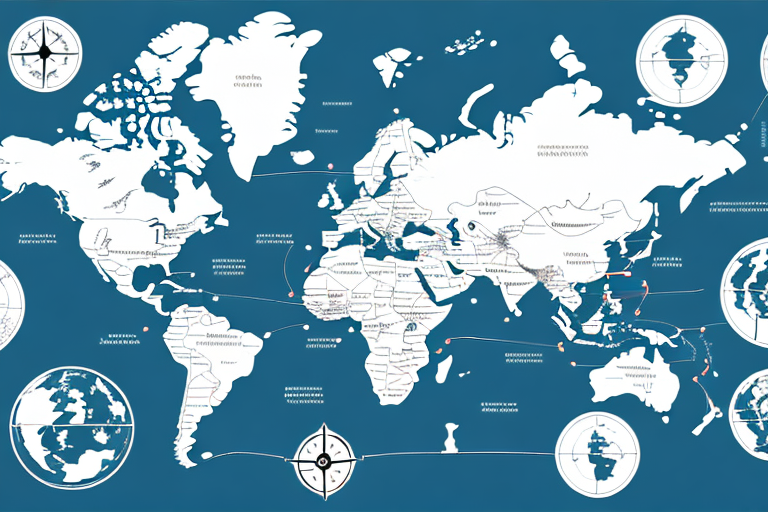How to Determine Shipping Rates with UPS
Are you searching for a reliable shipping carrier for your business? Look no further than UPS. With its expansive network covering over 220 countries and territories and a steadfast commitment to innovation, UPS remains a premier choice for both domestic and international shipments. But how exactly do you determine shipping rates with UPS? In this comprehensive guide, we delve into UPS shipping rates and provide detailed insights on how to calculate them effectively.
Understanding UPS Shipping Zones
A fundamental element in determining UPS shipping rates is the concept of shipping zones. UPS categorizes the United States into nine distinct shipping zones:
- Zone 1: Closest to the origin
- Zone 9: Farthest from the origin
The distance your shipment travels directly influences the shipping rate—the farther the destination, the higher the cost. Additionally, UPS considers the weight and dimensions of your package when calculating rates. Heavier and larger packages generally incur higher shipping costs, even within the same zone.
UPS offers a variety of shipping options, including Ground, Air, and International services, each with its own set of rates and delivery times. Carefully evaluating your shipping needs and selecting the appropriate service can help you secure the best rate and ensure timely delivery.
Factors that Determine UPS Shipping Rates
Beyond shipping zones, several other factors influence UPS shipping rates. These include:
- Weight and Size: Larger and heavier packages cost more to ship.
- Shipping Service: Premium services like UPS Ground are typically more affordable than expedited options.
- Destination: International shipments may incur additional fees and taxes.
- Delivery Speed: Faster delivery options come at a higher cost.
- Item Type: Shipping hazardous or fragile items may require special handling, increasing costs.
- Declared Value: High-value items may need additional insurance, affecting the overall rate.
For instance, sending a small package via UPS Ground service will typically cost less compared to shipping a large package using UPS Express Saver service to an international destination.
Comparing UPS Shipping Rates to Other Carriers
Before finalizing UPS as your shipping carrier, it's essential to compare their rates with other major carriers like FedEx and USPS. While UPS may offer competitive rates for certain services or destinations, other carriers might provide more cost-effective solutions depending on your specific needs.
- Package Size and Weight: Some carriers offer better rates for smaller packages, while others are more competitive with larger or heavier items.
- Delivery Speed: Compare the delivery times offered by each carrier to ensure they align with your business requirements.
- Service Restrictions: Different carriers have varied policies regarding package dimensions, weight limits, and item types.
Utilizing comparison tools and conducting thorough research can help you make an informed decision, ensuring you select the most economical and efficient shipping option for your business.
How to Calculate UPS Shipping Costs by Weight and Size
Calculating UPS shipping costs based on weight and size is straightforward with the right tools:
- Visit the UPS Rate and Service Guide or use the UPS online shipping calculator.
- Enter the weight and dimensions of your package.
- Specify the destination and desired shipping speed.
- The calculator will provide an estimated shipping cost based on the provided information.
Businesses that ship frequently or in large volumes can benefit from UPS Business Solutions, which offers customized shipping solutions and discounted rates. Enrolling in this program can lead to significant savings on overall shipping costs.
Using UPS Online Tools to Estimate Shipping Costs
UPS provides several online tools to streamline the shipping process and help estimate costs accurately:
- UPS WorldShip: A software application enabling the creation of shipping labels, managing shipments, and tracking packages. It offers access to UPS's shipping rates and services, allowing businesses to choose the best options for their needs.
- UPS CampusShip: A web-based tool designed for businesses with multiple locations. It centralizes shipping processes, allowing users to manage and track shipments from any internet-enabled computer.
By leveraging these tools, businesses can automate their shipping processes, reduce errors, and optimize their shipping strategies.
For more information, visit the UPS WorldShip Review and the UPS CampusShip Guide.
Negotiating Better Shipping Rates with UPS
Frequent shippers with significant volumes can negotiate better shipping rates with UPS. To leverage this advantage:
- Assess Your Shipping Needs: Understand your monthly shipping volume, average package size, and destinations.
- Contact Your UPS Representative: Discuss your shipping patterns and inquire about potential discounts based on your volume.
- Consider Long-Term Contracts: Committing to longer-term agreements may yield more favorable rates.
Having a clear understanding of your shipping requirements and demonstrating consistent shipping patterns can strengthen your position during negotiations, potentially leading to substantial cost savings.
Understanding UPS Surcharges and Fees
UPS may impose additional surcharges or fees based on various factors, including:
- Package Dimensions: Oversized packages may incur extra fees.
- Delivery Location: Deliveries to rural or remote areas can attract surcharges.
- Declared Value: Higher-valued items might require additional insurance costs.
Common surcharges include:
- Residential Delivery Surcharge: Applied to packages delivered to residential addresses to cover the extra costs associated with such deliveries.
- Additional Handling Surcharge: Charged for packages that require special handling, such as those exceeding 70 pounds or having irregular shapes.
Being aware of these surcharges allows you to factor them into your shipping costs and make informed decisions to minimize additional expenses.
Tips for Saving Money on UPS Shipping Costs
Implementing strategic approaches can help reduce your UPS shipping expenses:
- Consolidate Shipments: Combine multiple packages into a single shipment when possible to take advantage of bulk shipping rates.
- Use Lightweight Packaging: Opt for lighter materials to decrease the overall weight of your packages, leading to lower shipping costs.
- Leverage UPS Discounts and Promotions: Stay informed about ongoing promotions and discounts to benefit from reduced rates.
- Plan Ahead: Avoid rush delivery fees by scheduling shipments in advance whenever possible.
- Explore Alternative Shipping Options: For large or heavy items, consider freight shipping services, which may be more cost-effective than standard UPS services.
Additionally, selecting slower shipping methods like UPS Ground can significantly lower shipping costs if time constraints permit.
How to Choose the Right UPS Shipping Service for Your Needs
With a myriad of UPS shipping services available, selecting the most appropriate one can be daunting. Consider the following factors when making your decision:
- Delivery Speed: Determine how quickly your package needs to arrive. UPS offers options ranging from same-day delivery to standard ground shipping.
- Tracking Capabilities: Ensure the service provides adequate tracking features to monitor your shipment.
- Pricing: Balance cost against your delivery requirements to choose a service that fits your budget.
- Package Size and Weight: Verify that the chosen service accommodates the dimensions and weight of your package.
- Special Handling Needs: If shipping fragile or oversized items, select a service that offers specialized handling options.
If unsure about which service best suits your needs, consult with your UPS representative or explore the detailed UPS services on their official website.
Managing International Shipping with UPS
Shipping internationally with UPS involves additional considerations to ensure smooth and compliant delivery:
- Customs Documentation: Provide accurate and complete customs information, including the value and contents of your shipment.
- Import and Export Regulations: Familiarize yourself with the import and export restrictions of the destination country to avoid legal complications.
- Customs Clearance: Allow extra time for customs processing to prevent delivery delays. UPS offers customs brokerage services to facilitate this process.
- Shipping Costs: International shipping rates vary based on destination, weight, and size. Utilize UPS's international shipping calculators to estimate costs accurately.
UPS provides multiple international shipping services, including Air Freight, Ocean Freight, and Ground Shipping, catering to diverse shipping requirements and budgets.
For more detailed guidance, refer to UPS's International Shipping resources.
Tracking Your UPS Shipments
Once your shipment is in transit, UPS offers robust tracking capabilities to keep you updated:
- Tracking Number: Each shipment is assigned a unique tracking number that can be used to monitor its status.
- Online Tracking: Visit the UPS website and enter your tracking number to view real-time updates on your shipment's location and estimated delivery time.
- Mobile Alerts: Sign up for UPS My Choice to receive notifications via email or SMS about significant shipment events, such as when your package is out for delivery or has been delivered.
Additionally, UPS offers customizable tracking preferences, allowing you to tailor notifications to specific shipment events, ensuring you stay informed every step of the way.
Dealing with Common Issues During UPS Shipping
Despite meticulous planning, issues may arise during UPS shipping. Common problems include:
- Lost Packages: If your package isn't delivered as expected, contact UPS customer service immediately to initiate a search.
- Damaged Goods: Inspect packages upon arrival and report any damages to UPS promptly to file a claim.
- Delivery Delays: Weather conditions, customs processing, and other unforeseen factors can cause delays. Utilize tracking tools to stay informed and communicate with recipients about potential delays.
Addressing these issues swiftly by reaching out to UPS support can help resolve problems efficiently and minimize disruptions to your business operations.
Understanding Insurance and Liability with UPS Shipments
UPS provides liability coverage for packages based on their declared value. However, if the value of your package exceeds the standard coverage, it's advisable to purchase additional insurance to safeguard your items:
- Declared Value: UPS assigns a declared value to each shipment, which determines the level of liability coverage.
- Additional Insurance: For high-value items, purchasing supplementary insurance ensures comprehensive protection against loss or damage.
Carefully assessing the value of your shipments and opting for appropriate insurance coverage can provide peace of mind and financial protection for your business assets.
Best Practices for Packaging Your Items for UPS Shipment
Proper packaging is crucial to ensure your items arrive safely and intact. Follow these best practices when preparing packages for UPS shipment:
- Use Sturdy Boxes: Select high-quality, durable boxes that can withstand the rigors of shipping.
- Packing Materials: Utilize cushioning materials like bubble wrap, packing peanuts, or foam inserts to protect the contents.
- Secure Packaging: Reinforce packages with strong packing tape, especially at seams and corners, to prevent accidental openings.
- Clear Labeling: Clearly label your packages with the destination address, return address, and tracking information to facilitate accurate delivery.
- Weight Distribution: Evenly distribute the weight within the package to avoid imbalance and potential damage during transit.
Adhering to UPS's packaging guidelines can enhance the safety and reliability of your shipments, reducing the risk of damage and ensuring timely delivery.
In summary, understanding UPS shipping rates involves considering multiple factors, utilizing available online tools, and implementing strategic practices to optimize costs and efficiency. By leveraging UPS's vast network and comprehensive services, businesses can achieve reliable and cost-effective shipping solutions both domestically and internationally.




















